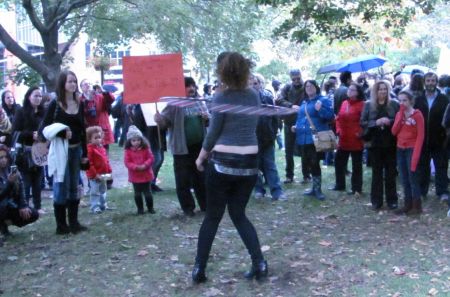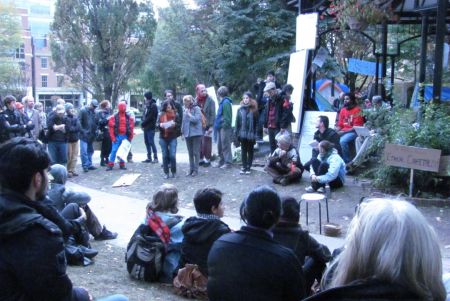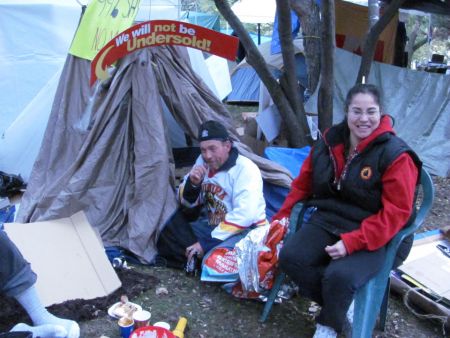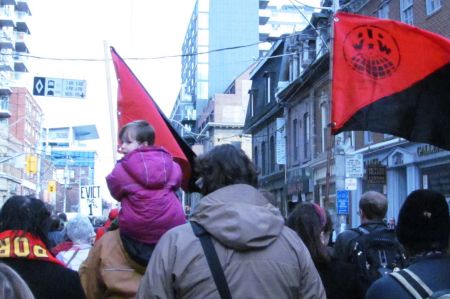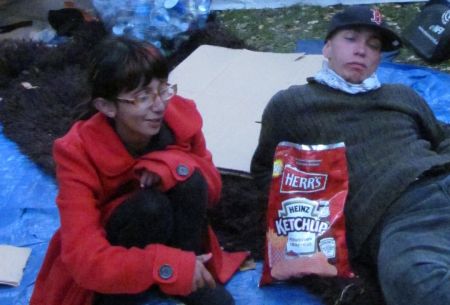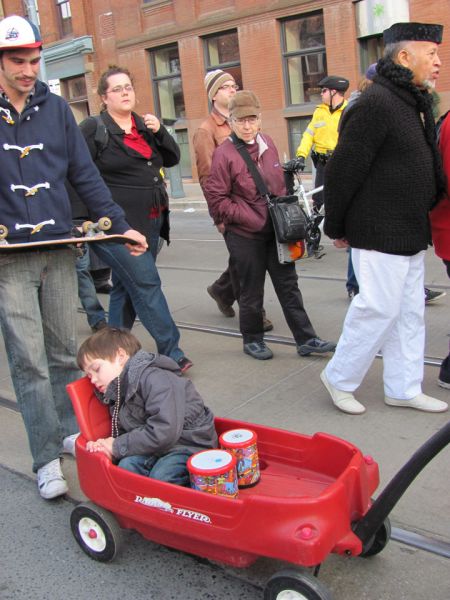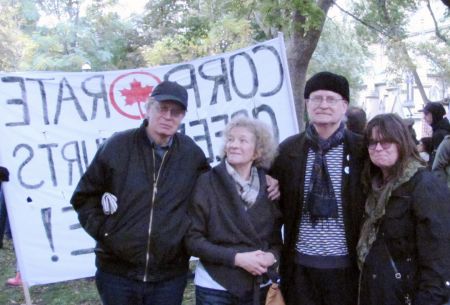November 18, 2011, Courtroom 4-7: “The City’s goal is to return the park to the members of the public,” declared its lawyer Darrel Smith to Justice David Brown. Such is the strangeness of the language around the Occupy movement, that Smith was able to announce that the City wanted to “liberate” the park so that the “public” could again have access to it.
The cornerstone of the City’s case is that the protestors are only being asked to vacate the park between midnight and 5:30AM. Ironically, in view of efforts Occupy TO made to enforce night-time quiet for the comfort of the neighbours, Smith pointed out that campers are not actually protesting during these hours. He argued that to evict the campers won’t violate their rights to freedom of expression because the conversation can be continued from 5:30AM to 11:59PM. The City’s case included affidavits and emails from neighbours opposed to the occupation. Supportive neighbours were present in the courtroom, but no evidence was presented to suggest their existence.
Occupy Toronto’s counsel Susan Ursel carefully presented a highly technical argument to a judge whose decision will be based on the Charter of Rights and Freedoms. On both sides the arguments relied largely on precedent, which seem to be few and indirect: including a small meditation hut erected by Falun Gong supporters across from the Chinese Consulate, and a tiny two-year long peace camp on Parliament Hill. The scale of Occupy Toronto seemed to make a negative impression on the judge, but Ursel argued that the power of individual rights should not be diminished by the number of individuals involved.
Jill Copeland of the Canadian Civil Liberties Union spoke to Charter issues, reminding the judge: “The public must tolerate some inconvenience or even financial loss for the sake of public expression.” Justice Brown replied, “My task is to figure out where the line is crossed with respect to ‘some inconvenience’ to ‘beyond the pale’.”
The City’s counsel Smith made much of the failure to apply for a permit to camp in St. James Park, and the judge’s multi-angled questioning elicited several admissions that the City did not see a need to attempt communication with Occupy TO beyond this initial permitting process. The camp’s chief hope is the sheer arrogance of the City in this respect, but it may not be much of a hope. For this writer, the ugliest part of the day was Brown and Smith’s dismissive laughter when Susan Ursel explained that the Camp delegated committees to respond to neighbors’ concerns and to engage with various City departments.
The lawyers were frequently interrupted and questioned by the judge. Ursel and Justice Brown alternately sparred, joked and expressed mutual sympathy for the daunting task of pulling together an “important” court case in five intense days. The judge advised that no side should “take comfort” in his aggressive questioning, saying that the public was witnessing a typical day in Motions Court. One can only hope. This comment was certainly not comforting to the campers: “I have to look at the precedential value of this… If every protest has a park, at the end of the day, where can I ride my bike?”
The judge questioned the choice of St. James Park as a location, asking why the occupation was not at City Hall, Queens Park or Bay Street. Ursel made a spirited defense of this park as an appropriate location “on the edge of the financial district,” close to the corporate entities that are the main targets of the protest. When the judge questioned whether this location had truly been used, Ursel seemed unaware of the frequent weekday actions, mentioning only the weekend marches on the downtown.
The greatest weakness in the Occupy camp’s case seemed to be that its counsel could not reassure the judge that the camp is not intended to be permanent. The City’s chief weakness was its failure to entertain any talks with the campers.
A sharp, devoted legal team has so far spared Occupy Toronto the several-stage eviction traumas experienced in Vancouver, Oakland and New York. Acting quickly to get an injunction against the pending eviction, it gave the community an extra week of wholeness. The General Assembly, committees, library, free school, free food and shelter program, had an extra week to continue the remarkable peoples’ think tank they’ve enabled to flourish. But a camper or two sitting at the counsel table might have helped Ursel to respond to the Judge’s provocative remarks, which gave her openings to present the human side of the occupation, or to dispute “facts” he presented from the City’s submissions.
An important question that was not asked on this long, too-short day in court was, “If we are talking about a bylaw violation, what would be a measured response on the part of the City?” Are they prepared to march in G-20 style and crack young, idealistic and vulnerable heads for the sake of sod damage that one big fundraiser could pay for? In that case, why not negotiate until March?
But as the city hammered away at its goal to “return the park to the “public,” the big unposed question was, “Who is the public?” St. James Park has never been so used or so loved. Is the "public" restricted to those who are afraid to ride their bikes, or are the many who take bikes daily also the public? Judge and City showed sympathy for those who claim they are afraid to bring their babies to a park brimming with eager, ragged young talkers. What about those who bring their kids to witness a fledgling democracy, and to enjoy the juggling and music? How much of the opposition to this movement is born of sheer prejudice against poor people and youth with pierced noses?
